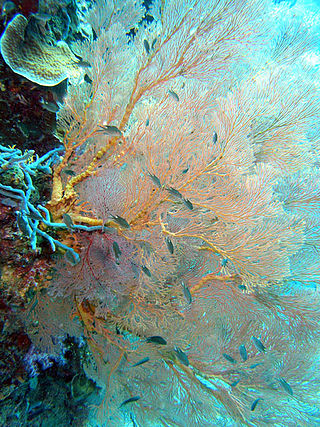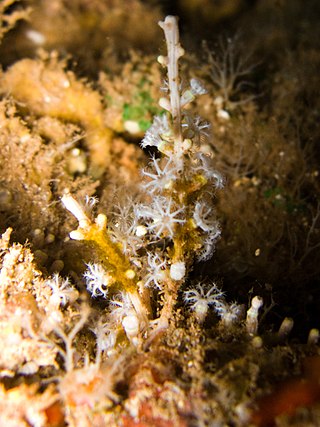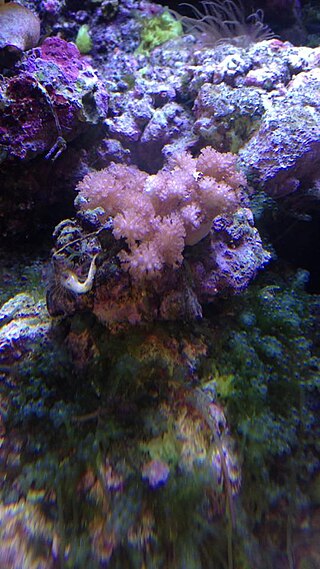
Alcyonacea are an order of sessile colonial cnidarians that are found throughout the oceans of the world, especially in the deep sea, polar waters, tropics and subtropics. Whilst not in a strict taxonomic sense, Alcyonacea are commonly known as soft corals. The term "soft coral" generally applies to organisms in the two orders Pennatulacea and Alcyonacea with their polyps embedded within a fleshy mass of coenenchymal tissue. Consequently, the term "gorgonian coral" is commonly handed to multiple species in the order Alcyonacea that produce a mineralized skeletal axis composed of calcite and the proteinaceous material gorgonin only and corresponds to only one of several families within the formally accepted taxon Gorgoniidae (Scleractinia). These can be found in order Malacalcyonacea (taxonomic synonyms of include : Alcyoniina, Holaxonia, Protoalcyonaria, Scleraxonia, and Stolonifera. They are sessile colonial cnidarians that are found throughout the oceans of the world, especially in the deep sea, polar waters, tropics and subtropics. Common names for subsets of this order are sea fans and sea whips; others are similar to the sea pens of related order Pennatulacea. Individual tiny polyps form colonies that are normally erect, flattened, branching, and reminiscent of a fan. Others may be whiplike, bushy, or even encrusting. A colony can be several feet high and across, but only a few inches thick. They may be brightly coloured, often purple, red, or yellow. Photosynthetic gorgonians can be successfully kept in captive aquaria.

Xeniidae is a family of soft coral in the order Alcyonacea.
Parisis is a genus of corals in the monotypic family Parisididae.

Melithaea is a genus of octocorals in the family Melithaeidae. Members of the genus are commonly known as fan corals and are found in the tropical Indo-Pacific region. The type species is Melithaea ochracea.

Alcyonium is a genus of soft corals in the family Alcyoniidae and class octocorallia. Alcyonium generally called as dead men's finger.

Plexauridae is a family of marine colonial octocorals in the phylum Cnidaria. Members of this family are found in shallow tropical and subtropical seas. Many species contain symbiotic photosynthetic protists called zooxanthellae.

Sinularia is a genus of soft coral in the family Alcyoniidae. They are commonly known as leather corals and currently have 166 described species in the genus.

Eunephthya is a genus of soft corals in the family Nephtheidae. The genus is only known from South Africa

Bebryce is a genus of gorgonian-type octocorals in the family Plexauridae.
Taiaroa is a genus of deep-water, solitary marine octocorals in the family Taiaroidae. Taiaroa is monotypic in the family Taiaroidae and contains a single species, Taiaroa tauhou. The species was first described by the marine zoologists Frederick M. Bayer and Katherine Margaret Muzik in 1976. The scientific name derives from "Taiaroa", the submarine canyon off New Zealand in which the first specimens were found and "tauhou", the Maori word for "strange".

Clavulariidae is a family of soft corals in the suborder Stolonifera. Colonies in this family consist of separate retractable polyps growing from a horizontal, encrusting stolon or basal membrane. The tissues are stiffened by sclerites.

Carijoa is a genus of soft corals in the family Clavulariidae.

Cornularia is a genus of soft corals in the suborder Stolonifera.

Klyxum is a genus of animals in the family Alcyoniidae. They are commonly called cauliflower colt coral, or simply colt coral. These common names can also refer to the related genus Cladiella.

Lobophytum is a genus of soft corals commonly known as devil's hand corals or devil's hand leather corals.

Oulophyllia is a genus of stony corals in the family Merulinidae. Members of this genus are native to the tropical western and central Indo-Pacific region.
Sympodium is a genus of soft corals in the family Xeniidae.

Briareum is a genus of soft corals in the family Briareidae. The coral is cultivated by aquarium owners for its fluorescing polyps, which reveal themselves under actinic light. The genus is in need of extensive examination, as many specimens sold by marketers display unique and similar characteristics, but are often labeled as one species, Pachyclavularia violacea.
Corymbophyton is a monotypic genus of corals belonging to the monotypic family Corymbophytidae. The only species is Corymbophyton bruuni.
Aquaumbra is a monotypic genus of corals belonging to the monotypic family Aquaumbridae. The only species is Aquaumbra klapferi.















